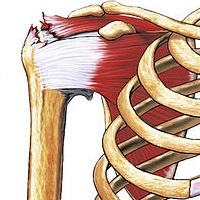
Photo from wikipedia
CONTEXT The supraspinatus muscle has an important role in the stabilization of the glenohumeral joint. Identifying abnormalities concerning its size and the subacromial space in the presence of pain may… Click to show full abstract
CONTEXT The supraspinatus muscle has an important role in the stabilization of the glenohumeral joint. Identifying abnormalities concerning its size and the subacromial space in the presence of pain may be relevant to provide more specific treatments focused on the etiology of pain. OBJECTIVE To determinate whether painful shoulder causes changes in the supraspinatus cross-sectional area (CSA) and the acromio-humeral distance (AHD) between overhead athletes. DESIGN Cross-sectional study. SETTING University campus and local sports clubs' Physical Therapist room. PARTICIPANTS 81 male overhead athletes were divided into 2 groups according to the presence of shoulder pain and clinical symptoms. MAIN OUTCOME MEASURES Ultrasonography measurements of the supraspinatus CSA and the AHD in 2 groups of overhead athletes with and without pain. RESULTS In the pain group, the CSA was significantly smaller compared with the no pain group. No differences between groups were found in the AHD measurement. CONCLUSIONS Shoulder pain in overhead athletes was associated with a reduction in their supraspinatus muscle CSA, but not in the AHD. These findings suggest that muscle atrophy exists in the presence of pain. However, in active overhead athletes, the AHD is not clearly reduced in overhead athletes with shoulder pain. Further studies are needed to understand this condition.
Journal Title: Journal of sport rehabilitation
Year Published: 2017
Link to full text (if available)
Share on Social Media: Sign Up to like & get
recommendations!